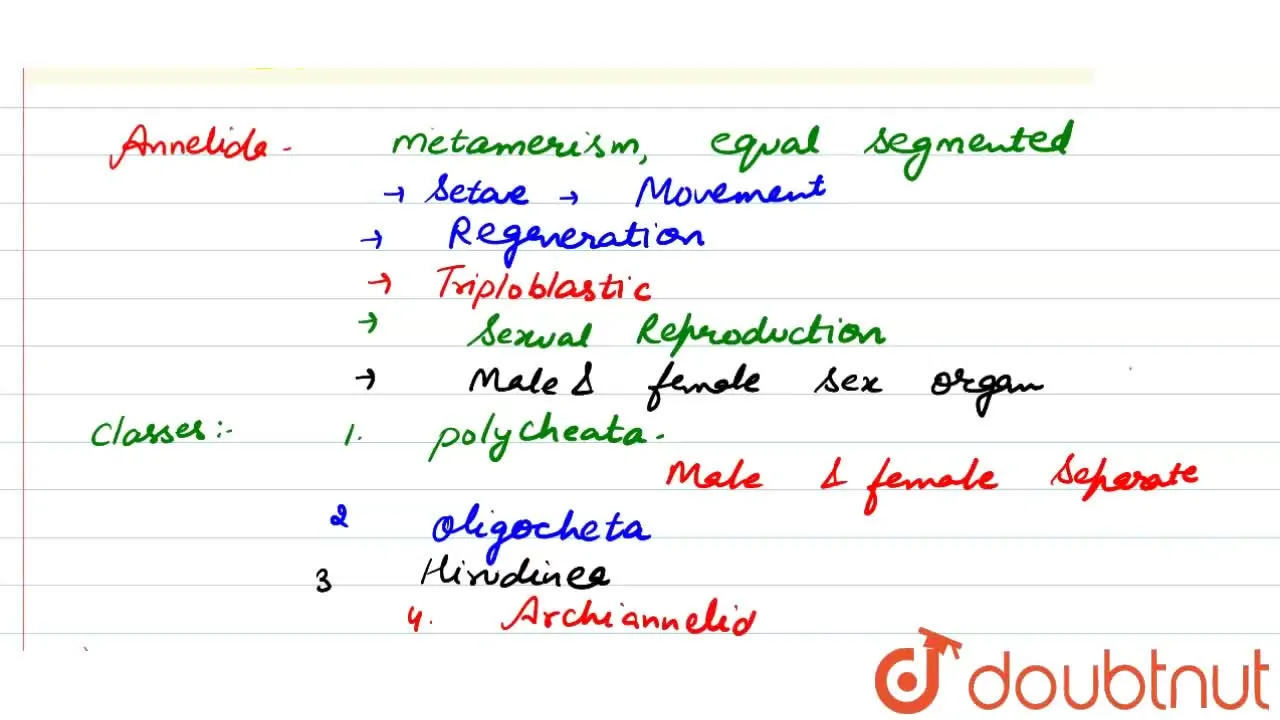Escribe important characters of phylum Annelida and name its classes with few characters.Solution in Punjabi
Video Solution
Text Solution
Linnaeus (1758) included all soft-bodied worms in “Vermes". Lamarck (1801) established phylum Annelida for higher types of worms. Characters :
1. Habitat. These are mainly aquatic, marine or fresh water, some terrestrial, fossorial, sedentary or free living, some commensal or parasitic.
2. Germ layers. These are triploblastic, have ectoderm, mesoderm and endoderm.
3. Body cavity. These are coelomate. Body cavity is schizocoel. It is divided by transverse septa into compartments.
4. Symmetry. These are bilaterally symmetrical.
5. Head. They may have distinct head.
6. Skeleton. They have hydroskeleton of the body.
7. Segmentation. These are metamerically segmented animals.
8. Level of organisation. These have organ system level of organisation.
9. Body form. Body is soft, elongated, vermiform or cylindrical.
10. Body wall. It consists of thin and moist cuticle, single layered epidermis and smooth circular and longitudinal muscles.
11. Appendages. Locomotory appendages are segmentally arranged, paired setae.or parapodia may be present or absent. Advantages are simple and unjoined structures.
12. Digestive system. Alimentary canal is complete, digestion is extracellular.
13. Respiratory system. Respiration occurs through general body surface or by gills in some cases.
14. Circulatory system. Blood vascular system is of closed type. Respiratory pigments are either haemoglobin or erythrocruorin dissolved in blood. plasma. Blood has amoeboid corpuscles.
15. Excretory system. Excretion is through nephridia. These also maintain osmoregulation. Aquatic annelids are ammonetelic and terrestrial ureotelic. -
16. Nervous system. Nervous system comprises of cerebral ganglia, segmental ganglia connected by ganglionated ventral nerve cord.
17. Sense organs. Sense, organs are tactile organs, taste buds, statocysts, photoreceptor cells and eyes.
18. Reproduction. These animals may be - unisexual or bisexual.
19. Development. Development is indirect and has a trochophore larva in polychactes. Asexual reproduction is by budding. Regeneration is common.

|
Updated on:21/07/2023
Similar Questions
Describe the important characters of animals belonging to phylum annelida.
01:31View SolutionWrite the general characters of phylum Annelida.
03:17View SolutionWrite the general characters of phylum Annelida.
03:17View SolutionDescribe important characters of phylum Porifera and its different classes.
View SolutionDescribe important characters of phylum coelenterata and name its classes with examples.
View SolutionDescribe different characters of phylum Arthropoda, name its classes with examples.
View SolutionDescribe the characters of phylum mollusca. Name its classes with examples.
02:28View Solution


